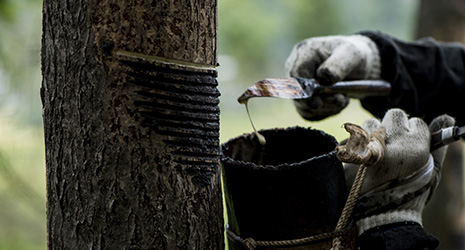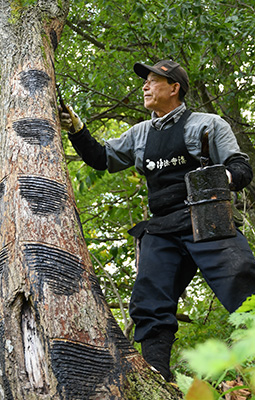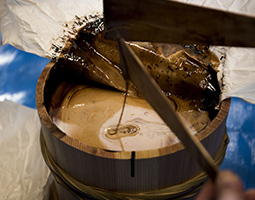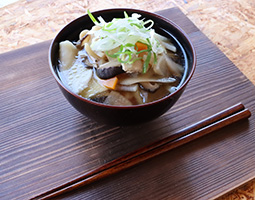May 2022
- English
- 日本語
Joboji Urushi Lacquer and Joboji-nuri Lacquerware

A lacquer tapper collects small amounts of sap oozing from a lacquer tree 
A stone blade colored with lacquer excavated in the Kamisugisawa archeological site in Joboji Town, Ninohe City, Iwate Prefecture

A lacquer tapper at work in Joboji Town, Ninohe City, Iwate Prefecture 
Joboji Urushi is stored in wooden barrels 
Joboji-nuri sake cups and server 
Joboji-nuri soup bowl with chopsticks

Produced using traditional techniques, Joboji Urushi lacquer is highly regarded both for the vibrant colors it creates and for its remarkable durability.

According to the Ministry of Agriculture, Forestry and Fisheries of the Japanese government, the production of Japanese lacquer in 2020 was about 2 tons. Joboji Urushi makes up about 1.5 tons of that. Joboji Urushi is mainly produced in and around Joboji Town, Ninohe City in northern Iwate Prefecture in the Tohoku region of northeast Japan. In this area rich in lacquer trees, people have long used lacquer, which is produced from the sap of the lacquer tree. A stone tool colored with lacquer, estimated to have been made 2,300 years ago, has been excavated in the Kamisugisawa archeological site in the town.
Since the 1950s, the production of domestic lacquer has declined significantly in Japan due to the spread of plastic products and the increase in imports of foreign lacquer. Under such circumstances, in Ninohe City, residents, private companies, and the local government have cooperated to continue to preserve the lacquer tradition through various initiatives, such as planting lacquer trees and nurturing artisans related to lacquer.

Joboji Urushi is not only produced in large volumes, but is also known for its high quality, for example by exhibiting high strength after painting and excellent durability, and producing vibrant red and black colors in lacquerware. For these reasons, it has also been used to restore and repaint World Heritage Sites like the Konjikido of Chuson-ji Temple in Iwate Prefecture, Nikko Toshogu in Tochigi Prefecture, and Kinkaku-ji Temple in Kyoto Prefecture.
An indispensable technique for collecting high-quality lacquer is “urushi kaki” (lacquer tapping). Lacquer tapping is the technique of scratching the surface of a lacquer tree and collecting the small amounts of lacquer that leak out slowly with specialized tools. Lacquer tappers go into the mountains from June to November and collect lacquer little by little from about 200 trees. The freshly collected lacquer is milky white, but it gradually turns more brown. Individual trees are scratched once every few days. Scratching a tree without days to rest in-between puts stress on the tree and reduces the amount of lacquer. In six months, about 200 milliliters of lacquer can be collected from a single tree. In 2020, as a technique that requires expert skill, lacquer tapping was inscribed as a technique among “traditional skills, techniques and knowledge for the conservation and transmission of wooden architecture in Japan” in UNESCO’s Representative List of the Intangible Cultural Heritage of Humanity.

“According to those skilled in lacquer tapping, if you make a mistake in judging the length, depth, or days of rest when scratching the wood, you will not be able to collect lacquer as you want,” says an official of the Ninohe City Lacquer Industry Division.
Lacquer collected by lacquer tappers is turned into paint following refinement through stirring and extracting excess water by heat treatment as well as mixing with other ingredients to change the color into red or black. Products manufactured using the Joboji Urushi made in this way are called “Joboji-nuri lacquerware.” Joboji-nuri lacquerware is said to have started in the Heian period (late eighth century to late twelfth century) with the lacquering of self-made bowls and plates used for meals by Buddhist monks at Tendai-ji Temple, which remains a place of worship in Joboji Town to this day. Later, because of how it combines simple beauty and sturdiness, it spread throughout the country as a type of lacquerware for everyday use.

In Joboji-nuri lacquerware, the nurishi (also called a nushi) lacquer painter applies lacquer to a wooden material with a brush, dries it, and then polishes it with sandpaper, repeating the process at least six times.
“The major features of Joboji-nuri lacquerware are its smooth touch, beautiful appearance with vibrant and deep colors, and high durability. Also, if you use it every day, a natural sheen will appear. It is a kind of lacquerware that lets you enjoy changes like that as well,” says the official of Ninohe City.

Joboji-nuri lacquerware can be enjoyed not only as dishes for Japanese cuisine, but also as plates for serving French cuisine or cups for drinking wine, among other expanding uses. The unfading beauty of Joboji Urushi will last long into the future.

